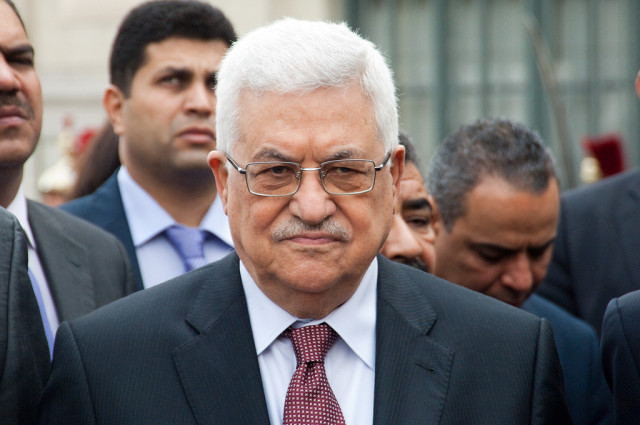The impending visit of Mahmoud Abbas to Washington on Wednesday coupled with moves on Capitol Hill to cut off funding to the Palestinian Authority (PA) as a result of Palestinian terrorism makes this a good time to focus on Palestinian governance.
Once the Trump administration does, it will find Palestinian governance has not gone well — despite or perhaps even because of the billions in foreign aid, including American money, pumped into the PA. For example:
The authority’s 2016 budget shows estimated expenditures of $4.25 billion but revenues of only $2 billion. That includes more than $1 billion in contributions from the United Nations Relief and Works Agency (UNRWA), the European Union and the United States. In perspective, the gross domestic product (GDP) of the territory under supervision of Mr. Abbas‘ PA (the West Bank and Gaza Strip, population estimated at more than 4 million) is about $12.1 billion; Vermont’s GDP (population approximately 625,000) is $29 billion. The PA was established in 1994 as a result of the Oslo Accords. The international community — led by the United States — provided funds to the nascent administration to help it create self-government for the vast majority of the Palestinian Arabs.
The authority also was to conduct negotiations with Israel over “final status issues,” namely Jerusalem, refugees, settlements, security and borders. The job was to be completed by 1999.
Oslo did not mandate an independent Palestinian state, but rather “recognize[s] [Israeli and Palestinian] mutual legitimate and political rights.” That could be independence or nonsovereign self-rule. It also stated that “negotiations on the permanent status will lead to the implementation of Security Council resolutions 242 (1967) and 338 (1973)” under which Israel is entitled to “secure and recognized boundaries free from threats or acts of force,” among other things.
In 2000, 2001 and 2006-08, the United States and Israel offered Palestinian leadership statehood directly. The first two offers were made regardless of the so-called “second intifada” — the Palestinian terror war against Israel — that killed 1,137 Israelis and wounded 8,341 from 2000 to 2005. (The U.S. equivalent would be 45,480 dead, 333,640 injured — a factor of 40.)
Israeli Prime Minister Ehud Olmert said of the negotiations that started just after relative calm was restored, “From the end of 2006 until the end of 2008, I think I met with [Mahmoud Abbas] more often than any Israeli leader has ever met any Arab leader. I met him more than 35 times. They were intense, serious negotiations.”
Mr. Olmert’s offer included 97 percent of the West Bank, resettlement of some — by no means all — Palestinian refugees, territorial exchanges, and rights in Jerusalem. Mr. Abbas verified as much in a 2009 interview and confirmed that he declined the offer.
During all that time — and beyond — money flowed from the international community to the Palestinian Authority, more than $17 billion by 2016. The U.S. contribution alone to the UNRWA — which subsidizes Palestinian Arabs designated as refugees, regardless of whether they ever lived in what is Israel — (2000-2014) was $2.6 billion.
It isn’t only money. At the end of the 70-country “peace process” conference in Paris in January, the closing communique was a statement of Palestinian failure to govern. The attendees expressed their readiness “to exert necessary efforts in particular in the areas of political and economic incentives, the consolidation of Palestinian state capacities, and civil society dialogue.” Those include:
• “Continued financial support to the Palestinian Authority in building the infrastructure for a viable Palestinian economy.
• “Supporting and strengthening Palestinian steps to exercise their responsibilities of statehood through consolidating their institutions and institutional capacities, including for service delivery.
• “Convening civil society fora, in order to enhance dialogue between the parties, rekindle the public debate and strengthen the role of civil society.”
After 23 years and billions of other people’s dollars, time and expertise, Palestinian Arabs still lack “infrastructure for a viable economy,” cannot “exercise their responsibilities,” or manage “service delivery.” And there is no “civil society” able to express dissent or disapproval of Mahmoud Abbas’s 12-year power grab based on a four-year presidential term.
The Gaza Strip under Hamas, a U.S.-designated terrorist organization, is worse. Hamas and Mr. Abbas‘ Fatah movement continue to fight an off-and-on civil war of words, money and weapons.
President Trump expresses optimism over the possibility of an Israeli-Palestinian peace deal. But as things stand, Mr. Abbas‘ Washington visit does not change the fact that an independent Palestinian state would be born a “failed state.” Absent proper governance by and in the Palestinian Authority, the United States should hold off on a new “Palestine.”


